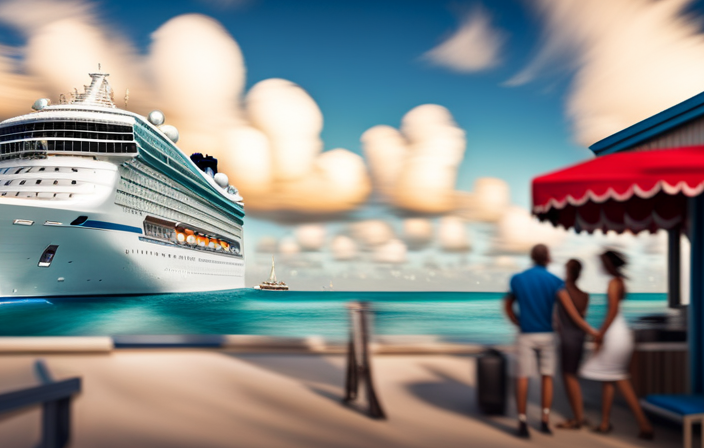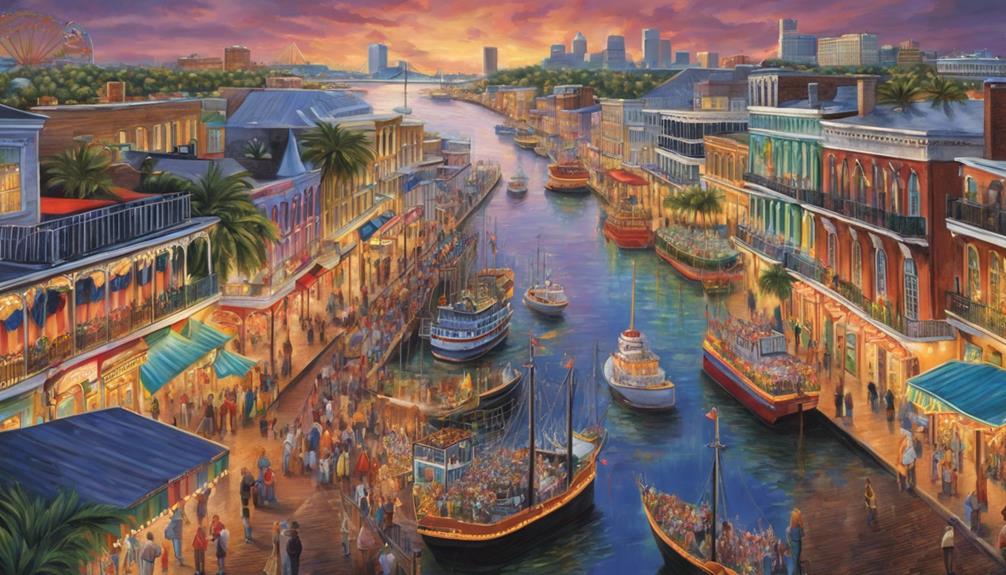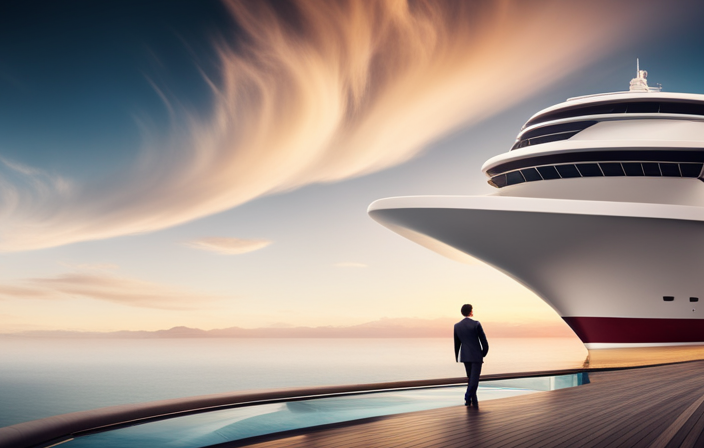Gazing upon the immense stretch of the Atlantic Ocean, I’m filled with a feeling of amazement contemplating the journey across its waves. The combination of thrill and expectation, along with the detailed planning and preparatory work needed for this voyage, fosters a mood of fascination and mystery.
In this article, I will delve into the factors that affect the duration of an Atlantic crossing, the popular routes for transatlantic cruises, and the types of vessels used for this remarkable adventure. I will provide detailed information on planning your transatlantic cruise, including safety and security considerations, as well as tips for a smooth crossing.
Along the way, I will highlight the captivating sights and experiences that await you, while also acknowledging the challenges that come with a transatlantic voyage. So join me as we embark on this extraordinary journey across the Atlantic, discovering the joys and wonders that lie ahead.
Key Takeaways
- The duration of an Atlantic crossing is influenced by factors such as route choice, weather conditions, ship speed, and size.
- Transatlantic cruises can range from 6 to 14 days in duration.
- There are different types of vessels for transatlantic cruises, including cruise ships, sailing yachts, and catamarans, each offering unique advantages.
- When planning a transatlantic cruise, it is important to consider factors such as itineraries, the best time to travel, cruise ship amenities, and safety considerations.
Factors Affecting the Duration of an Atlantic Crossing
If you’re wondering how long it takes to cruise across the Atlantic, there are several factors that can significantly affect the duration of your journey. The first factor is the route you choose to take. While there are several popular routes for transatlantic cruises, some may be longer than others due to navigational constraints or preferences.
Another major factor influencing cruise duration is the weather conditions encountered during the journey. Strong winds, storms, or adverse currents can slow down a cruise and add extra days to the overall travel time. It’s crucial for cruise captains to monitor weather forecasts and adjust their course accordingly to minimize any potential delays.
These factors, along with others such as ship speed and size, can determine whether your crossing will be a swift one or a more leisurely voyage.
Popular Routes for Transatlantic Cruises
One of the most sought-after routes for transatlantic cruises is the famous ‘sailing the pond’ journey. This iconic voyage takes travelers across the vast Atlantic Ocean, offering breathtaking views and memorable experiences.
Popular departure ports for transatlantic cruises include Miami, New York, and Southampton. These cities serve as gateways to the open waters and offer a variety of amenities for cruise passengers before embarking on their adventure.
Transatlantic cruise itineraries can vary in duration, typically ranging from 6 to 14 days. During this time, passengers can enjoy a host of onboard activities, entertainment, and gourmet dining options.
As we transition into the subsequent section about the duration of a transatlantic cruise, it’s important to consider the various factors that can influence the length of the journey.
Duration of a Transatlantic Cruise
Get ready to embark on an incredible adventure as you set sail on a transatlantic voyage, experiencing the thrill of traversing the vast ocean and discovering new horizons. When planning a transatlantic cruise, there are several factors affecting the duration of the journey that you should consider. The most significant factor is the route chosen, as it determines the distance to be covered. The table below provides an overview of popular routes and their estimated durations:
| Route | Duration (in days) |
|---|---|
| Miami to Barcelona | 14 |
| Southampton to New York | 7 |
| Rome to Miami | 15 |
| Lisbon to Rio de Janeiro | 19 |
Other planning considerations include the speed of the vessel, weather conditions, and any scheduled stops along the way. These factors can impact the overall duration of the cruise. As you explore the types of vessels for transatlantic cruises in the next section, you’ll discover how different ships offer varying speeds and amenities to enhance your journey.
Types of Vessels for Transatlantic Cruises
When it comes to transatlantic cruises, there are several types of vessels to choose from.
Cruise ships are the most common option, offering a wide range of amenities and activities for passengers.
Sailing yachts provide a more intimate and personalized experience, allowing passengers to feel closer to the water and the elements.
Catamarans, on the other hand, offer stability and speed, making them a popular choice for those who prefer a smoother and faster journey.
Each type of vessel has its own unique advantages, and the choice ultimately depends on the preferences and needs of the individual traveler.
Cruise Ships
To estimate how long it takes to cruise across the Atlantic, you might consider the various factors that influence the duration of your journey. Cruise ship amenities and transatlantic cruise itineraries play a significant role in determining the time it takes to cross the ocean.
Cruise ships are designed to provide a luxurious and comfortable experience for passengers, offering a wide range of amenities such as restaurants, spas, entertainment venues, and pools. These amenities contribute to the overall travel time as passengers may choose to spend more time enjoying the onboard facilities rather than focusing solely on the journey.
Additionally, transatlantic cruise itineraries vary in terms of ports of call and the amount of time spent at each destination, which can impact the overall duration of the cruise.
With this in mind, let’s now transition to the subsequent section about sailing yachts.
Sailing Yachts
Sailing yachts offer a unique experience on the open ocean, where the wind becomes a guiding force, transforming the vessel into a graceful dancer on the waves. To navigate the vastness of the Atlantic, sailors must employ various sailing techniques to harness the power of the wind effectively. Adjusting the sails, trimming them to catch the optimal wind angle, and using the right amount of sail area are crucial elements in achieving efficient sailing.
Weather conditions play a significant role in determining the speed and duration of a transatlantic sail. Favorable winds, such as the trade winds, can propel a sailing yacht at a good pace, reducing the time it takes to cross the Atlantic. However, adverse weather conditions, such as storms or doldrums, can pose challenges and prolong the journey.
Transitioning to the subsequent section about catamarans, these multi-hulled vessels offer a different yet equally thrilling experience on the open ocean.
Catamarans
If you want to experience the exhilaration of gliding across the open ocean with ease and stability, catamarans offer a unique and captivating alternative.
Catamarans provide numerous benefits that make them an excellent choice for transatlantic cruising. First and foremost, their twin hull design ensures exceptional stability, reducing the likelihood of rolling and making them more comfortable in rough seas. This stability also allows for increased speed, as catamarans have less drag compared to monohulls.
Additionally, their wide beam provides ample space for comfortable living quarters, including spacious cabins, salons, and outdoor areas. Catamarans also offer better maneuverability and shallow draft, allowing you to explore secluded anchorages and navigate closer to shore.
In comparison to monohulls, catamarans provide a smoother and more enjoyable sailing experience. Transitioning to planning your transatlantic cruise, it’s essential to consider factors such as weather patterns and route selection.
Planning Your Transatlantic Cruise
Hey there! When you’re mapping out your transatlantic cruise, don’t forget to factor in the duration of the journey. Here are four important things to consider when planning your transatlantic cruise:
-
Transatlantic Cruise Itineraries: There are various transatlantic cruise itineraries available, ranging from 7 to 21 nights. Choose one that suits your preferences and allows you to explore different ports of call along the way.
-
Best Time to Take a Transatlantic Cruise: The best time to embark on a transatlantic cruise is during the spring or fall seasons when the weather is milder and the seas are calmer. This ensures a more comfortable and enjoyable journey.
-
Cruise Ship Amenities: Look for a cruise ship that offers a wide range of amenities to keep you entertained during the crossing. From multiple dining options and onboard activities to spa treatments and live entertainment, there’s something for everyone.
-
Onboard Enrichment Programs: Many transatlantic cruises offer enrichment programs such as lectures, workshops, and classes. Take advantage of these opportunities to learn something new and make the most of your time at sea.
Now that you have your transatlantic cruise planned, let’s dive into the exciting activities and entertainment awaiting you on board.
Activities and Entertainment on a Transatlantic Cruise
Once you’ve meticulously planned your transatlantic voyage, indulge in the diverse activities and entertainment that await you onboard. From relaxing spa treatments to thrilling performances, there is something for everyone to enjoy. Take a dip in the swimming pool or challenge yourself in the state-of-the-art fitness center. For those seeking adventure, try out the rock climbing wall or test your putting skills on the mini golf course. If you prefer a more laid-back experience, catch a movie at the onboard cinema or immerse yourself in a captivating book at the library. In the evenings, be entertained by live music performances or try your luck at the casino. With a wide range of activities and entertainment options, your days at sea will be filled with excitement and relaxation. Transitioning into the subsequent section about ‘safety and security considerations’, it is important to also be aware of the necessary precautions to ensure a safe and enjoyable journey.
Safety and Security Considerations
Ensuring your safety and security throughout your transatlantic voyage is of utmost importance, so it’s essential to familiarize yourself with the necessary precautions.
To maintain a safe environment, cruise ships implement various safety measures. These include conducting regular safety drills to familiarize passengers with emergency protocols, such as evacuation procedures and the proper use of life jackets. Additionally, cruise ships are equipped with advanced technology to detect and respond to potential security threats.
Closed-circuit television (CCTV) cameras, security personnel, and access control systems are in place to monitor and control the movement of passengers and crew. In the event of an emergency, the ship’s crew is trained to handle various situations and coordinate with authorities on land.
By adhering to these safety measures, you can enjoy a worry-free transatlantic crossing. As we move on to the next section about tips for a smooth transatlantic crossing, it’s important to keep in mind that safety should always be a top priority.
Tips for a Smooth Transatlantic Crossing
To make your transatlantic voyage more enjoyable, here’s a tip: don’t forget to pack some seasickness medication! When embarking on a smooth transatlantic crossing, there are a few essential tips to keep in mind:
-
Pack Layers: The weather can be unpredictable at sea, so it’s important to bring a variety of clothing options. Be prepared for both warm and cool temperatures by packing layers that can easily be added or removed.
-
Stay Hydrated: It’s easy to become dehydrated while cruising across the Atlantic, so make sure to drink plenty of water throughout the journey. This will help prevent headaches, fatigue, and other symptoms of dehydration.
-
Plan Activities: With long stretches of time at sea, it’s essential to plan activities to keep yourself entertained. Bring books, games, or hobbies that you enjoy to pass the time and make the crossing more enjoyable.
As you prepare for your transatlantic adventure, keep in mind these tips for a smooth crossing. Now, let’s explore the captivating sights and experiences along the way.
Captivating Sights and Experiences Along the Way
As I embarked on my transatlantic crossing, I was captivated by the abundance of wildlife encounters along the way. From graceful dolphins leaping out of the water to majestic whales breaching the surface, the open ocean was teeming with life.
The stunning sunrises and sunsets that painted the sky with vibrant colors added an ethereal beauty to the journey. Additionally, observing the diverse marine life, such as schools of colorful fish and curious sea turtles, provided a fascinating insight into the underwater world.
Wildlife Encounters
During the cruise across the Atlantic, you’ll have the chance to spot fascinating wildlife along the way. The vast expanse of the ocean provides a unique opportunity to witness marine animals in their natural habitat.
Here are three incredible wildlife encounters you may experience during your journey:
-
Whale Watching: Keep your eyes peeled for majestic humpback whales breaching the surface of the water. These gentle giants migrate across the Atlantic, and their conservation efforts have helped their population rebound in recent years.
-
Dolphin Delight: Look out for playful dolphins leaping through the waves. These intelligent creatures often travel in pods, and their acrobatic displays are a sight to behold.
-
Seabird Spectacle: As you sail across the Atlantic, you’ll likely spot a variety of seabirds soaring above the water. From graceful albatrosses to charismatic puffins, these birds add a touch of beauty to your journey.
The best time to spot marine animals is typically during the summer months when the waters are warmer and more abundant with food. After encountering these fascinating creatures, prepare to be mesmerized by the stunning sunrises and sunsets that await you.
Stunning Sunrises and Sunsets
Witnessing the breathtaking sunrises and sunsets in the middle of the vast ocean is an experience that fills the heart with awe and wonder. As the sun begins to rise, the sky transforms into a canvas of vibrant colors, with hues of pink, orange, and gold. The rays of light reflect off the calm waters, creating a mesmerizing reflection that stretches as far as the eye can see. In the evening, the sunsets are equally mesmerizing, as the sun slowly sinks below the horizon, casting a warm glow across the ocean. These stunning sunrises and sunsets provide the perfect backdrop for photography opportunities, capturing the beauty of nature in its purest form. The breathtaking landscapes created by these celestial events are truly unforgettable. Transitioning into observing marine life, one can’t help but be in awe of the wonders that lie beneath the surface.
Observing Marine Life
Exploring the vast ocean aboard a cruise ship allows for the incredible opportunity to witness the mesmerizing beauty and diversity of marine life. As a passionate advocate for marine life conservation, I find it particularly fascinating to observe these creatures in their natural habitat. Here are four remarkable aspects of observing marine life during a cruise:
- Breathtaking encounters with majestic whales, dolphins, and sharks.
- Captivating interactions with vibrant coral reefs, teeming with colorful fish and other marine species.
- The chance to witness the grace and elegance of sea turtles as they gracefully glide through the water.
- The opportunity to capture stunning underwater photography, documenting the wonders of the deep sea.
By immersing myself in the world of marine life, I’m not only able to appreciate its beauty but also gain a deeper understanding of the importance of marine life conservation.
Transitioning into the subsequent section, let’s now explore the joys and challenges of a transatlantic cruise.
The Joys and Challenges of a Transatlantic Cruise
Imagine the exhilarating journey of cruising across the Atlantic, where you can embrace the joys of discovering new horizons while navigating through the challenges of unpredictable waves.
The joys of a transatlantic cruise lie in the sheer vastness of the ocean, the breathtaking sunsets, and the opportunity to witness marine life in its natural habitat.
However, planning and preparation are crucial to ensure a smooth and enjoyable experience. Weather conditions, safety measures, and provisions must be carefully considered.
The challenges of a transatlantic cruise include navigating through rough seas, avoiding storms, and maintaining the ship’s stability. It requires expertise in reading weather patterns, constant monitoring of the vessel’s condition, and effective communication with the crew.
Despite the challenges, the rewards of a transatlantic cruise are immeasurable, offering a unique opportunity to disconnect from the world and immerse oneself in the wonders of the open ocean.
Frequently Asked Questions
Can I bring my pet on a transatlantic cruise?
Yes, pets are allowed on certain transatlantic cruises. There are pet-friendly cruise options available for those who wish to bring their pets along. These cruises provide amenities and services for pets onboard.
What is the average cost of a transatlantic cruise?
The average price of a transatlantic cruise varies depending on factors such as cruise line, cabin type, and amenities. To get the best deal, it is recommended to book your cruise well in advance.
Are there medical facilities on board transatlantic cruise ships?
Yes, there are medical facilities on board transatlantic cruise ships. In case of medical emergencies, there is onboard medical staff available to provide necessary medical care and assistance to passengers.
Can I use my cell phone or access the internet while on a transatlantic cruise?
While on a transatlantic cruise, I can use my cell phone and access the internet. The ship’s satellite communication system allows for continuous connectivity, ensuring I can stay connected with the outside world throughout my journey.
Are there any age restrictions for passengers on transatlantic cruises?
There are no age restrictions for passengers on transatlantic cruises. However, it is important to check with the specific cruise line for any pet policies that may apply.
Conclusion
In conclusion, embarking on a transatlantic cruise is an awe-inspiring adventure that requires careful planning and consideration.
From the factors affecting the duration of the journey to the different types of vessels available, there are numerous aspects to consider.
Ensuring safety and security, as well as being prepared for the joys and challenges of the voyage, is crucial.
So, set sail and immerse yourself in the captivating sights and experiences that await you on this rhythmic and flowing journey across the Atlantic.










